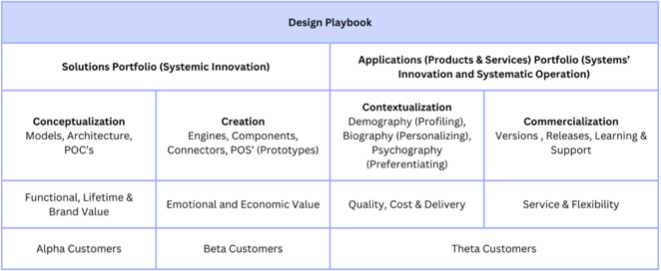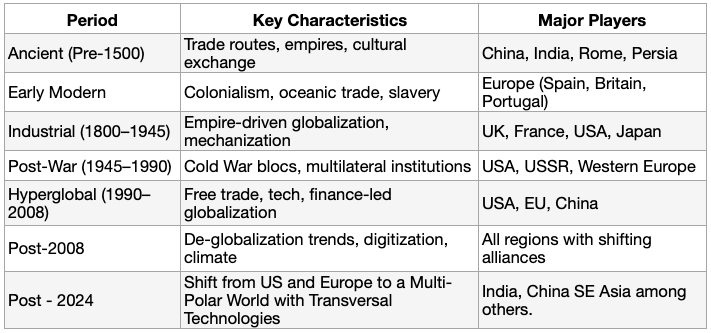Is your Global Capability Center (GCC) an Innovation Powerhouse?
By Subbu Iyer & Siddharth Patel
We are currently at a Strategic Inflection Point (SIP) on our planet, where life is being redefined by a single, dominant force: digital technologies. The Technological Advancements are reshaping everything around us, leaving little trace of our past. Throughout history, our societies have faced similar disruptions, such as the revolutions brought about by fire, mechanization, communications, information, and internet technology. Leaders have consistently embraced the power of transformation with eagerness and enthusiasm, while laggards have often needed to be coerced along, much like sacrificial goats, by their stakeholders and shareholders.
This article delves into the emerging convergence of Life and Technology, demanding individuals, industries, and institutions transcend mere competence and pursue excellence through the lens of capability. This transformation will have a profound impact on the future of work.
Over the last 319 years, since the Industrial Revolution began in 1706, fueled by scientific discoveries, society has gradually settled into a pattern of mass consumption and mediocrity, with the notable exception of the rise of internet commerce. However, we are now witnessing a revitalized society characterized by five key forces:
An Aspirational generation that sees Diversity, Equity, and Inclusion (DEI) as a birthright.
Transversal technologies with the Potential Capacity to Connect Life.
The emergence of New Materials, Resources, and Energy promoting Sustainability.
The necessity for investments to Create Value for Creators and Consumers powered by the Data Continuum.
The power of digital infrastructure bridging the physical and virtual realms.
Globalization must be viewed in this renewed context, keeping the threats of Hyper Nationalism, Geo-Political Instability, Decaying Global Institutions such as the WHO, UN and WTO in mind. A brief history and the evolution of Globalization is summarized in the following Table.
We are witnessing a paradoxical age: a globally connected world increasingly torn by fragmentation, tribalism, and nationalistic retrenchment. Solving this will require not just diplomatic recalibration, but a moral and technological transformation, where global citizenship and local identity are not at odds, but harmonized through intelligent, inclusive, and glocal strategies.

Global Capability Center (GCC), when viewed through a modern lens, will redefine all the three terms 1. Global, 2. Capability and 3. Centers will need to be understood afresh in the context of shaping the future that will of course impact the Future of Work.
Global as Glocal
The main difference between the terms Global and Glocal, besides the replacement of the B with the C is the ‘People to People Connect’ anywhere on the planet and the formation of Autonomous Communities that are free from the Control of Industries and Institutions. One that does not interfere with the Goals & Objectives of an Enterprise and actually contributes to it with greater felicity through the process of Co-Creation. Manifesting the formula made famous by C K Prahalad and N S Krishnan in their seminal work “The New Age of Innovation: Driving Co-Created Value through Global Networks” authored 17 years ago. Where N = 1 is a Unique Experience that is Created by R = G, a Global Resource that is best suited for the Purpose.
A Role Driven Digital Identity System with Data Autonomy that allows Individuals to share and co-create with trust in an end-to-end encrypted environment where users own the data they create and consume.
Capabilities
Every major disruption has demanded that societies acquire New Capabilities. Where the term Capabilities encrypts two core concepts: ”the Capacity to transform" and "the Ability to perform”. Highlighting the need to go beyond mere competence to pursue excellence as a way of progressive growth, leveraging the new advancements. It is important to recognize that Digital forces capability enhancement for both the Creator and the Consumer, with the Potential of the Data Continuum accelerating Transformative Growth in our Societies.
"A capable Individual, Industry and / or Institution is not one that just gets things done, but one that redefines what needs to be done.”
Centers
Global Capability Centers (GCCs) have transformed over the past two decades, evolving from mere Outsourcing Posts to Captive Centers, and are now striving to become Innovation Hubs. However, new entrants as well as the incumbents still struggle to meet the current demand for Digital Transformation Hubs. It’s essential to view this situation through the lens of a Digital Strategy rather than focusing solely on location. While aiming for cost savings is nothing to be ashamed of, it shouldn't come at the expense of innovation.
"Don’t just change your address — change your access. In a digital world, location is no longer a place, it’s a platform."
A significant lesson learned from the experiences of GCCs that have operated for the past two decades, as well as those recently established, is that GCCs should not merely serve as extensions or branches of existing Enterprise Architecture. Instead, they should function as Centers of Excellence (COE) that drive and shape new structures (relationships), synergies (culture), and systems (digital).
These Centers must influence and challenge the existing organization to prevent resistance to transformation. This approach simulates the real world, where true revolutionary startups are expected to disrupt the status quo. With over 95% of startups ultimately failing, this scenario does not currently pose a significant threat.
Cost Arbitrage Versus Value Creation
The average total cost for technology personnel in the U.S. currently ranges between $170,000 and $190,000 per full-time equivalent (FTE) annually, with figures surpassing $210,000 in high-cost markets. According to E&Y, the estimated annual FTE cost in a GCC is $29,100, potentially rising to $37,760 by 2030. Both estimates reflect organizations structured for performance with a strong emphasis on cost savings.
"The very systems designed to optimize performance are often the ones that suppress potential.”
It is a misconception that talent is readily productive in any market globally to tackle the challenges posed by technological advancements. It would be prudent to allocate at least $25,000 per Full-Time Equivalent (FTE) annually for the next 5 years towards reskilling efforts to ensure they are prepared for the future, regardless of location. Consequently, it is essential to shift the strategic focus from performance to potential. Investing in and identifying the best resources for driving an enterprise's future growth is a wise decision.
It should not matter whether an FTE costs $210,000 Per Year or $50,000 Per Year as long as they create commensurate value. This is where Strategy comes into play, that manifests Capability as:
Fusing Data, Talent, Materials / Resources / Energy, Financial Capital and Digital Infrastructure.
A Pipeline of Intellectual Property (IP) is created to serve the Glocal Market.
The System Engages, Rewards, Recognizes and Celebrates the Formula of N=1; R=G
Value Creation moves from the narrow definition of a Client as a Customer to a Universe of Customers including Associates, Stakeholders, Shareholders, Business Partners, Vendors, Societies and Technology who Create and therefore are also entitled to Consume the returns on Value.
Enterprise Design Playbook
It should be very clear by now that the creation of Global Capability Centers must be preceded by Enterprise Design. But that is not how history has turned out. And this is the moment to pivot. Where Enterprise is a Concept or Model that must be brought to life through Business (Operations) optimally. This needs advanced Visualization that highlights the Capabilities required to realize the Vision. This should be the primary responsibility of a Global Capability Center (GCC).
Design has progressed through various phases, transitioning from Industrial Design to Functional Design, then to Design Thinking, and now to Design Learning. This evolution signifies a crucial transformation: moving design beyond simple organization to encompass orchestration as well. In this new Learning Cascade, the reorganization of structures flows into synergies and systems seamlessly, devoid of the typical dysfunctions associated with renewal.
Design Learning is relevant today as our Systems are Continuously Learning and Adapting to the advancements of Technology. Where the core of the Systems is a data continuum; connecting the Creation at source to the consumption at various nodes that are sustained in a continuous loop. while AI / GI can automate, the manual intervention in terms of governance and algorithms that run Logic and Rules are still critical interventions. This is the potential of human and technology collaboration to build responsible systems with role-driven ecosystems.

The Dynamic Nature of the Modern Design Playbook
The modern design playbook is not merely a static document; it serves as a living artifact that is collaboratively developed in real time. This is why it is often described as orchestrating the harmonious interplay between strategy and design. Here, strategy is represented by five major and forty-two minor dimensions of enterprise transformation, while design reflects the capacity to implement the attributes of each dimension on a scale ranging from innocence to excellence.
Creating Distinct Environments
Illustration 3 above clearly highlights the necessity for separate environments dedicated to conceptualization and engineering for solutions, as well as personalization and commercialization for applications. This approach facilitates the creation and transportation of intellectual property (IP) in a stage-gated and risk-assured manner.
GCC as a Strategic Investment
Here are nine factors that will help a GCC to be set up as a Strategic Investment. The Intent of a GCC is the enterprise becoming an Innovation Powerhouse and the Impact contributing to the Growth of the Customer Universe.
In Conclusion
If innovation is not a core intent of a Global Capability Center (GCC), it becomes a significant waste of time, energy, and effort. The true advantage of a GCC lies in leveraging potential rather than merely focusing on performance. Establishing GCCs presents a valuable opportunity to address the core of the enterprise and taking ownership of it because the IP of an enterprise lies there. It should not be viewed as a mere displacement strategy but it will replace outsourcing and irrelevant talent. The GCCs must embody the mindset of a startup and should influence the organization's culture much like reverse osmosis.
References:
AI won’t cure ‘the infinite workday’ unless companies reengineer work, Microsoft says




